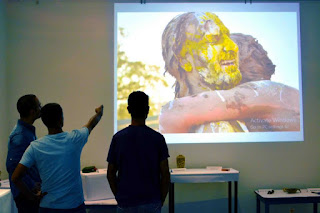Late Middle English: from Old French climat or late Latin clima, climat-, from Greek klima ‘slope, zone’, from klinein ‘to slope’. The term originally denoted a zone of the earth between two lines of latitude, then any region of the earth, and later, a region considered with reference to its atmospheric conditions.
Latitudes and Longitudes are imaginary lines. Atmosphere is invisible. Climates affect us, nonetheless, in unknown ways.
Floods, quakes, winds but also capital and guns have altered geographies and disrupted memories. We live in an engineered climate today; created and destroyed by opposing political wills, pointless perversity, fossilized ideas, new technology, laughable exaltations, fear psychosis, new medical disorders, plastic flowers, fake encounters, torture labs, frothing drains. Snow in summers. The desire for the new world is conflicted between creation and destruction.
We wish to explore artistic renditions and vocabularies of damages and fissures that survive in such climates.
Maraa in collaboration with 1 Shanthi Road is proud to present
The Memory of A Deluge and the Surface of Water
a Collection of Text and Image Fragments by Art Students in the Srinagar Art College, Kashmir in the wake of the destruction of their College in a Flood in Autumn, 2014.
The deluge of September 2014 wrecked havoc in the valley of Kashmir. It besieged the homes of people, drowned the hearts of lovers, stormed the minds of poets, assaulted everything, everyday, while the waters rose. The memory of rising water remains embedded in everyone's memory in Kashmir, and has become impossible to forget or overcome.
This is what we celebrate here, in these short texts that the students of the Art College at Srinagar wrote, invented and performed after they left the flood in Kashmir behind them. For many months they travelled, with images of objects that had emerged from the flood waters in Kashmir. These images and memories of what the flood waters left in their wake became anchors for their practice, their education, their future as artists.
Join us for the exhibition, followed by a discussion with faculty and students from the college.
Latitudes and Longitudes are imaginary lines. Atmosphere is invisible. Climates affect us, nonetheless, in unknown ways.
Floods, quakes, winds but also capital and guns have altered geographies and disrupted memories. We live in an engineered climate today; created and destroyed by opposing political wills, pointless perversity, fossilized ideas, new technology, laughable exaltations, fear psychosis, new medical disorders, plastic flowers, fake encounters, torture labs, frothing drains. Snow in summers. The desire for the new world is conflicted between creation and destruction.
We wish to explore artistic renditions and vocabularies of damages and fissures that survive in such climates.
Maraa in collaboration with 1 Shanthi Road is proud to present
The Memory of A Deluge and the Surface of Water
a Collection of Text and Image Fragments by Art Students in the Srinagar Art College, Kashmir in the wake of the destruction of their College in a Flood in Autumn, 2014.
The deluge of September 2014 wrecked havoc in the valley of Kashmir. It besieged the homes of people, drowned the hearts of lovers, stormed the minds of poets, assaulted everything, everyday, while the waters rose. The memory of rising water remains embedded in everyone's memory in Kashmir, and has become impossible to forget or overcome.
This is what we celebrate here, in these short texts that the students of the Art College at Srinagar wrote, invented and performed after they left the flood in Kashmir behind them. For many months they travelled, with images of objects that had emerged from the flood waters in Kashmir. These images and memories of what the flood waters left in their wake became anchors for their practice, their education, their future as artists.
Join us for the exhibition, followed by a discussion with faculty and students from the college.









